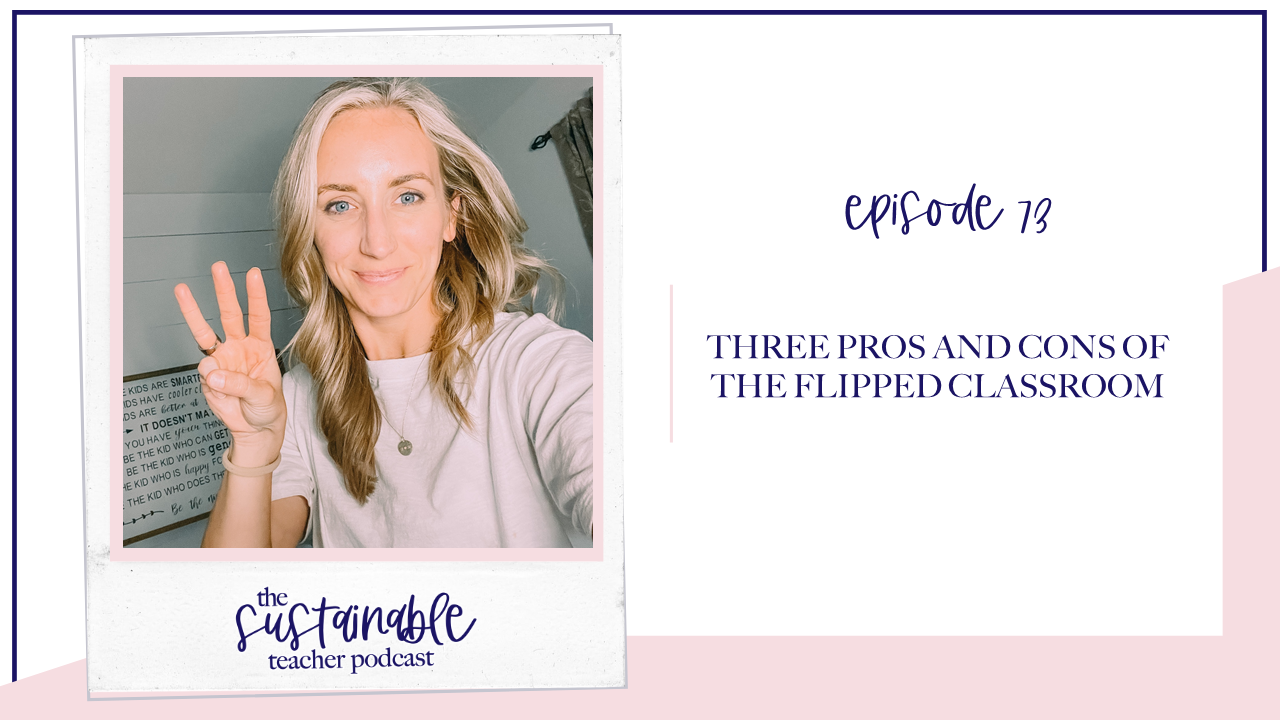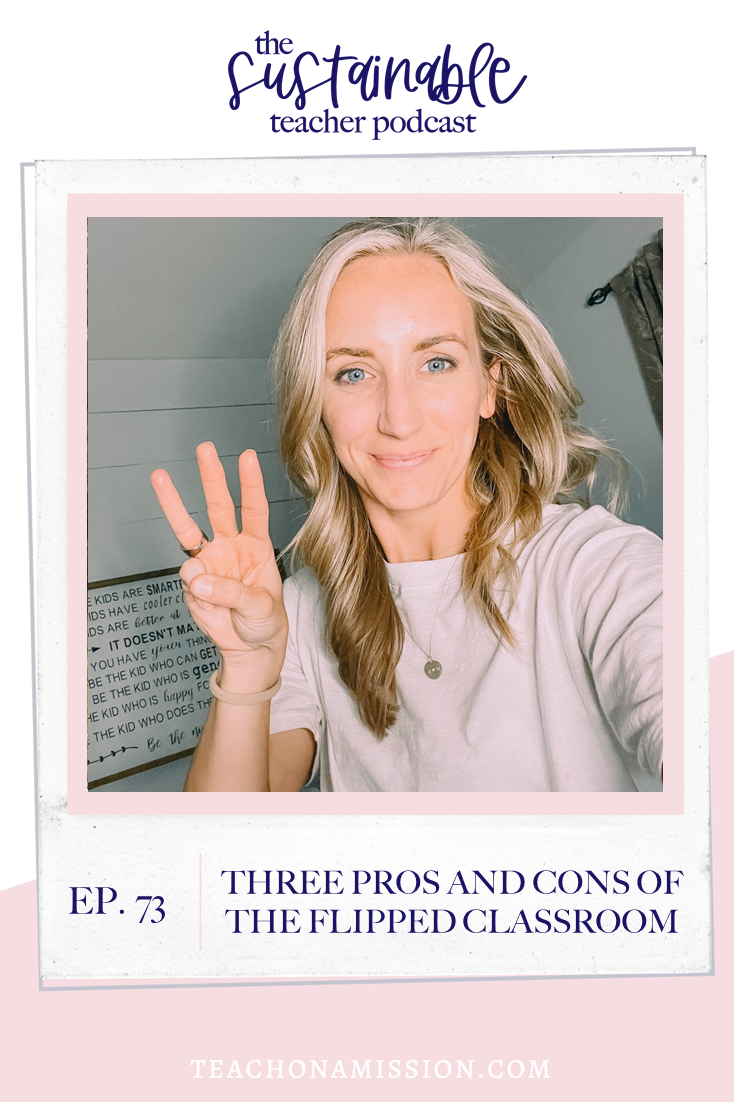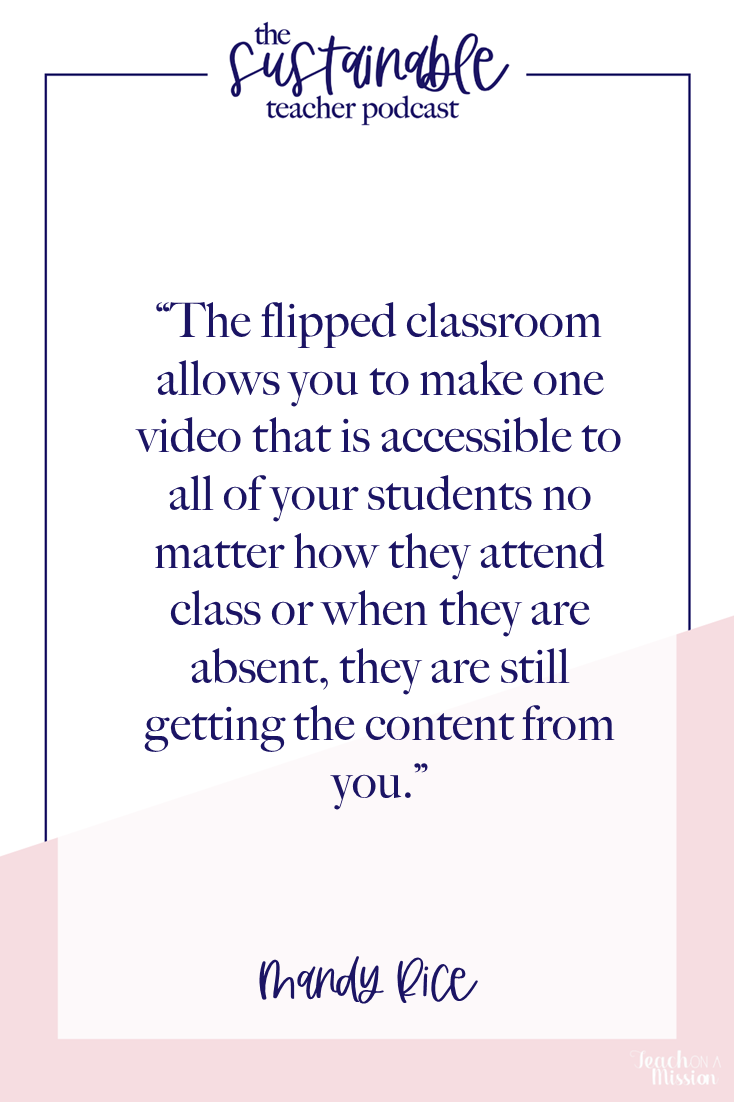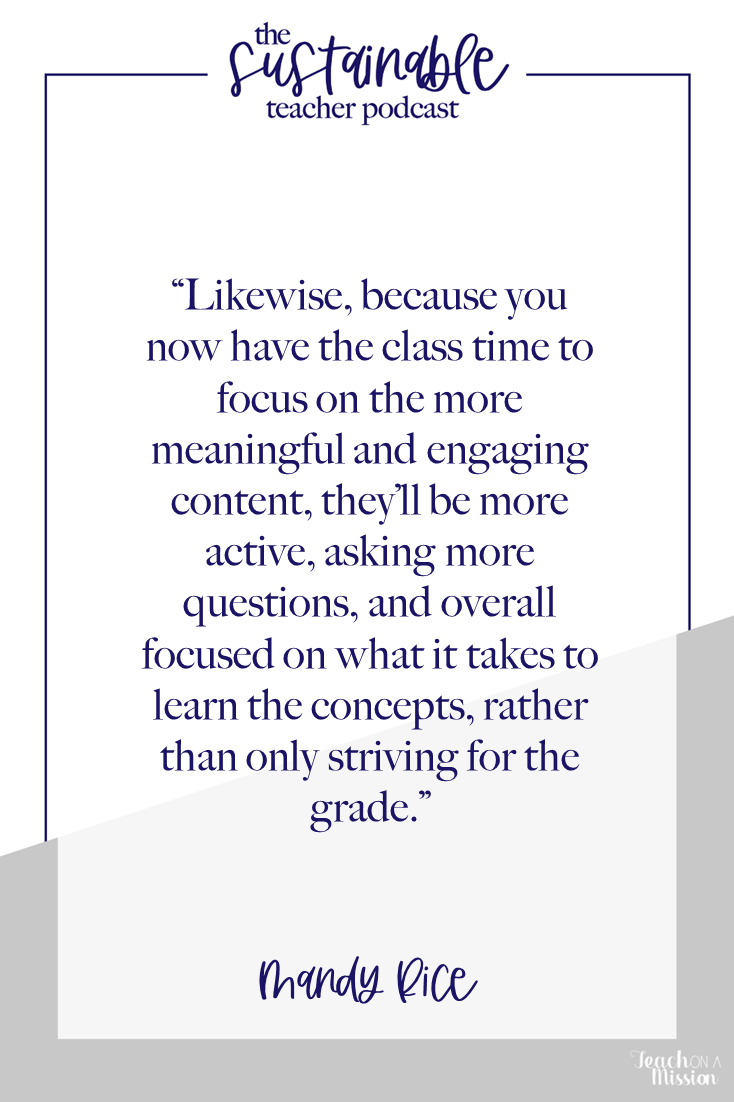The Three Pros and Cons of Flipping Your Classroom

“The flipped classroom was a strategy I knew I wanted to implement, but I never saw it coming when my flipped classroom gave my students more access during the pandemic and is now a strategy that provides me more sustainability in my post-pandemic classroom.”
This is a quote from a teacher whom I’ve helped flip their classroom, and seriously, I can’t say it much better than that.
Which is why in this episode I am going to dive into both the benefits and the drawbacks of flipping - at least from the perspective of someone who is considering flipping their classroom and hasn’t quite doven in yet (or maybe you have dabbled in the technique but not gone all in just yet).
After listening to this episode you’ll have a clear understanding of how the flipped classroom makes for a more sustainable and effective classroom in the post-pandemic world, knowing if the strategy is a good fit for you.
Because here’s the thing, although the post-pandemic classroom brings multiple additional hurdles, like students attending your classroom in different ways giving you what equates to more preps, as well as increased absences, and a list too long to get into, the standards are not going away. Which means the expectation is continued effectiveness and performance even though your day is increasingly less sustainable.
And this is the nature of the beast. This is unfortunately the new normal for at least the time being. Not to say that the systemic unsustainability of it all shouldn’t be addressed quickly and effectively, but if you’re anything like me, I’m not one to wait around on other people to make my situation better or what I want it to be.
So if you’re ready to make your post-pandemic classroom more effective for your students (no matter how they attend your class) and more sustainable for you in your daily teaching life, providing you more time at home and with your family, then this episode is for you.
And I’m betting this episode will resonate with one or two of your teacher-friends, and if that’s the case, go ahead and click that share button in the app where you’re listening, or copy the web address if you’re listening on our website, and send this episode over to them. I bet they’ll thank you for it, and I will too because your help in getting our message into the ears of more teachers means the world to me.
Alright, let’s get to the episode on Flipped Classroom Pros and Cons, so grab your pen and paper if you’re a note-taker and let’s get to it.
Let’s jump right in here by sharing the pros and then the cons of flipping your classroom in hopes that you’re able to pick up a few pointers and tips along the way to implement in your own flipped classroom.
Flipped Classroom Pros
I’m starting with the pros because I want to bring a light of positivity and get you in the right mindset around the possibilities of flipping. Some of these may be repeats you’ve heard on other episodes, but they bear repeating here because these pros really are that great.
Accessible Content to All Students
If your post-pandemic classroom will include students reporting to you both in person and remotely, OR if you’re seeing the insane rise in student absences and are feeling the pressure to keep up with it all, as if it’s your problem kids have been gone, then accessible content for ALL students because of they ONE way you deliver is the answer.
It’s imperative that you deliver your content in a way that’s sustainable for you here, and delivering the same content multiple times a day live and in person, just isn’t a great use of your time, when you could be doing it just once and in a way that reaches ALL of your students, and that is through video.
So this is pro number one - the flipped classroom allows you to make one video that is accessible to all of your students no matter how they attend class or when they are absent, they are still getting the content from you.
More Meaningful Use of Class Time
And the second pro piggy-backs off of the first. Because you’ll be making accessible content for all students, it will be streamlined and therefore take up less time, which means more class time can be dedicated to the meaningful and harder parts of learning.
Why is it that the harder parts of learning, like practicing and applying are traditionally outside the classroom, and therefore away from the teacher?
Doesn’t make sense, when it could be IN class where the student has access to their peers and to their teacher to help them work through their mistakes in ways that inform their learning and provide meaningful feedback in real time.
Not to mention the class time you’ll now have for the human connection piece. Kids are craving it, and you’re stressed over taking class time for it - no more. Build those relationships, teacher-friend, and don’t feel guilty for it because they’re still getting the content.
Overcome the Game of Grades
The last pro is that the flipped classroom will help you overcome the game of grade amongst your students. The focus of your classroom can authentically be pointed more toward learning and less toward the game of grades.
Because a student is able to move at their own pace through the content, and get meaningful feedback on their level of mastery (or lack thereof), the focus will almost automatically be on learning, rather than grades.
Likewise, because you now have the class time to focus on the more meaningful and engaging content, they’ll be more active, asking more questions, and overall focused on what it takes to learn the concepts, rather than only striving for the grade.
Flipped Classroom Cons
As promised, let’s consider some perceived cons of the flipped classroom to make sure that you feel 100% on your decision to flip or not.
It Takes Too Much Time
The first perceived con of the flipped classroom is that it takes a ton of time to flip the classroom. Between making the videos, teaching your students the concept, and then knowing what to do in class, it just takes too much time.
This is definitely a big one that I hear from teachers, and I definitely want to face it head on. Here’s the truth about time. Let’s consider how much time you take to deliver one piece of content or one lecture right now. If you’re the average middle or high school teacher (and for my elementary school teachers, think of your equivalent to this which would be multiplied by each of the core content areas), let’s say you teach one course 4 times throughout the day, American History for instance, and it’s time for you to deliver your lecture on the Industrial Revolution which takes about 30 minutes. You’re delivering the same lecture for 30 minutes for each of your 4 periods, and let’s say you teach that course for 10 years. Because, you know, what we teach changes, so let’s just go with 10 years.
That’s 20 hours of doing the same exact thing over and over again - and that’s only for one lecture.
So, does the flipped classroom take time? Yes, of course it does - everything you do in your classroom takes time. But let’s be aware of how we’re using our time right now, and how we might use it better in the future.
Instead of doing the same exact thing for 20 hours, let’s take one hour (probably less) to make a quick video for our students, which frees up the rest of the 19+ hours to serve our students in more ways.
Doing it On Your Own
The next con of the flipped classroom which is a real one I see in all aspects of most professional development, not just that surrounding the flipped classroom, is having to do it on your own.
You know the story - you find something great you want to learn about and implement in your classroom. And then, IF you get the gumption to ask for support, most of the time the answer is “we don’t have the time or the funds right now, but it sounds like a great idea, I bet you could do it on your own, you rockstar, so go for it.”
This is what I call the Teacher DIY status quo of education.
And, I’m telling you teacher-friend, it’s killin’ us.
It’s so draining to not have support from someone who has done it before, helping us guide our path to make sure we’re using our time as effectively as possible, and not having to use a ton of time just researching the possibilities or options for each step of the way.
I’ve done this before. I flipped my own classroom for 10+ years and have now helped thousands of teachers flip their own classrooms as well. And if you’ll have me, I would absolutely love to help you do the same. Just stick around for a while, and I will certainly show you how.
Resistance from Students and/or Parents
The last potential con of flipping your classroom is the possible resistance of students and/or parents. Meaning, they come to class in those first few days, learn that you flip your classroom and throw a hissy-fit.
Yes, it's happened. In my ten-plus years of flipping it only happened to me once, but other teachers I’ve worked with have experienced it, and it may be something you are worried about.
The first thing I’ll say is that in my 10+ years of flipping it only happened once. And this student, like in many cases I’ve seen with teachers I’ve worked with, this student and her parents resisting the flipped classroom was not the only issue they were dealing with or fighting in the school. The lesson being to not take it personally.
The second thing I’ll say is that there are absolutely steps you can take to avoid this all-together, and it’s part of what I teach inside of my online course, Flipped Classroom Formula, and what I call having Flipped Classroom Foresight.
You’ve got to be proactive and see coming any potential hurdles of your flipped classroom for your students and parents. Just as you would prep your flipped classroom differently in a 1:1 devices classroom as a classroom of students with no devices, you should be equally prepared for students and parents who may not be on board for your flipping technique.
Communicate about it from the beginning - and don’t just communicate about it, teach about it. Both students and parents. Share the benefits, your personal story in why you did it, and the benefits you have seen and know you will see this year. Ultimately, the biggest benefit is for your students, so show them what those are, and then reassure them of your support and guidance if there are issues at any point in the year.
Alright, teacher-friend, there you have it for the three pros and three cons of the flipped classroom. I hope you found this knowledge and some baked-in recommendations as helpful in your professional development and consideration of the flipped classroom.
And if it did resonate with you, then I have an even better opportunity for you as you start this journey, and that is to join me LIVE in my upcoming teacher-professional development, How to Flip Your Classroom & Earn Graduate Credit in Less Than 90 Days: How to Plan, Build, and Implement a Thriving Flipped Classroom with the guidance of someone who’s done it before so that you hit the ground running and don’t have to sacrifice your evenings and weekends in the process!

Sounds like a B-A training for teachers who want to get back to the classroom and career they love, am I right?!? We’ll start off with finding your reason why you want to flip your classroom and we’ll even dive deeper into those reasons, because you’ll absolutely have more than one, and we’ll even create a vision board so you know exactly where you’re going and will know when you get there.
It’s totally free and I’ll provide a certificate of completion at the end that you can turn in for your continuing education credits.
To get your professional development workbook and a chance to earn some awesome flipped classroom templates, get registered now here.
Alright, before we go, I have one more thing to leave you with and that is this. No two flipped classrooms should look the same. So just because these pros or cons resonated with some doesn’t mean they all apply to you. And that’s what I’m here for. I am here to help you create the classroom that allows you to show up as the best version of you for your unique students which gives them the best version of an education they deserve.
If you’re here for it, get registered for that free pd now.
And I’ll see you right here, same time next week, bye for now.







